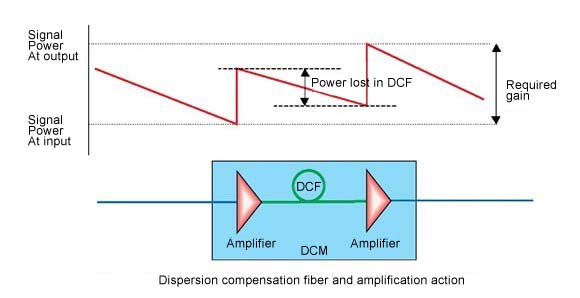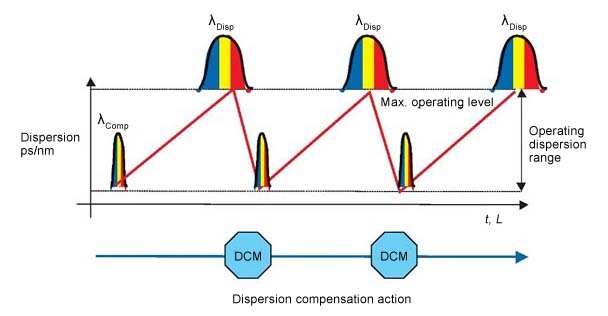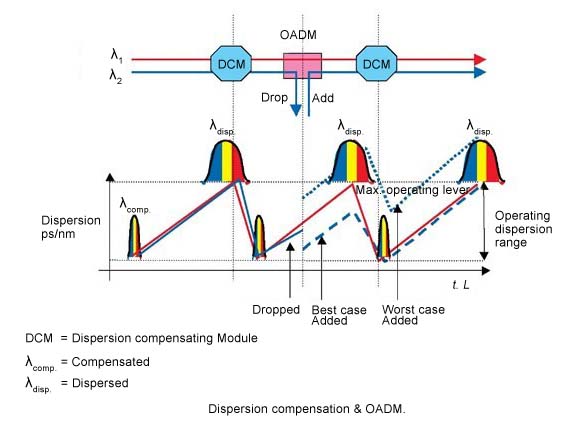FS-DCM-110 Dispersion Compensation Module
The Fiberinthebox Dispersion Compensation Module (FSDCM) provides negative dispersion for dense wavelength division multiplexing (DWDM) transmission systems and can be used to compensate dispersion on standard single-mode optical fiber (SMF) across the entire C-Band. The small form factor (SFF) of the FSDCM enables extended DWDM transmission in a very small footprint. When combined with Fiberinthebox transponders and amplifiers, the WRDCM provides a simple, reliable, and cost-effective DWDM transpo solution.
The FSDCM-20, -30, and -40 are specifically targeted for link pre-compensation and may be used before a booster amplifier. The FSDCM-20, -30, -40, -50, and -60 may be used for inline compensation or for post-preamp applications. The WRDCM can suppo single- or multi-channel (C-Band) applications at both 2.5 and 10 G line rates.
FS DCM can compensate the dispersion with optimized residual dispersion for standard single-mode fiber (G.652) in the C-band.The modules based on mature and reliable optical fiber technology with excellent performance for optical transmission system. DCM modules are available with any dispersion values from -10 to -2100 ps/nm at 1550nm wavelength. We Fiberinthebox stock a diverse selection of DCM, range from 10KM to 120KM.
The FSDCM-20, -30, and -40 are specifically targeted for link pre-compensation and may be used before a booster amplifier. The FSDCM-20, -30, -40, -50, and -60 may be used for inline compensation or for post-preamp applications. The WRDCM can suppo single- or multi-channel (C-Band) applications at both 2.5 and 10 G line rates.
FS DCM can compensate the dispersion with optimized residual dispersion for standard single-mode fiber (G.652) in the C-band.The modules based on mature and reliable optical fiber technology with excellent performance for optical transmission system. DCM modules are available with any dispersion values from -10 to -2100 ps/nm at 1550nm wavelength. We Fiberinthebox stock a diverse selection of DCM, range from 10KM to 120KM.
Key Features
100% slope compensation of G.652 fiber in C-band (Typical) Low Polarization Mode Dispersion Compensates standard single-mode optical fiber (G.652) Compatible with C-Band DWDM optical channels Low end-to-end inse ion lossVariety of compensation lengths19-inch 1RU rack mountable design
Applications
Typical Application Cases of FS-DCM Series


Compensated for the signal loss from DCF(dispersion compensating fiber) with amplifiers(a 5-km DCF may cause 2.5-dB losses.)

Dispersion compensating modules (DCM) have been engineered that are used in systems and/or in regenerators to help increase the span of fiber.

Optical add-drop multiplexers (OADM) may limit the dispersion. The reason is that the dispersion characteristics of a dropped signal and an added are not the same. This picture illustrates the point for the best and worst cases.
Ordering Information
| Product Code | Description |
| FS-DCM-10 | 10 km Dispersion compensation module |
| FS-DCM-20 | 20 km Dispersion compensation module |
| FS-DCM-30 | 30 km Dispersion compensation module |
| FS-DCM-40 | 40 km Dispersion compensation module |
| FS-DCM-50 | 50 km Dispersion compensation module |
| FS-DCM-60 | 60 km Dispersion compensation module |
| FS-DCM-70 | 70 km Dispersion compensation module |
| FS-DCM-80 | 80 km Dispersion compensation module |
| FS-DCM-90 | 90 km Dispersion compensation module |
| FS-DCM-100 | 100 km Dispersion compensation module |
| FS-DCM-110 | 110 km Dispersion compensation module |
| FS-DCM-120 | 120 km Dispersion compensation module |
Specifications
| Product | DCM-20 | DCM-30 | DCM-40 | DCM-50 | DCM-60 | |
| Optical Characteristics | ||||||
| Insertion Loss (dB)1 | 2.7 | 3.3 | 4.0 | 4.3 | 5.4 | |
| Dispersion ±2% (ps/nm) 2 | –325 | –487 | –650 | –812 | –974 | |
| PMD (ps) | 0.29 | 0.36 | 0.42 | 0.45 | 0.51 | |
| Physical Characteristics | ||||||
| Size (W x H x D) | 25.4 x 223 x 175 mm?1 x 6.89 x 8.8 in) | |||||
| Optical connectors and fiber type (all ports) | LC/PC bulkhead | |||||
| Weight | 0.36 kg(0.76 lb) | |||||
| Environmental Characteristics | ||||||
| Operating ambient temperature | –5°C ~ 55°C | |||||
| Storage temperature | –40°C ~ 85°C | |||||
| Relative humidity(non-condensing) | 5% ~ 95% | |||||













